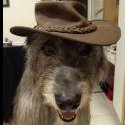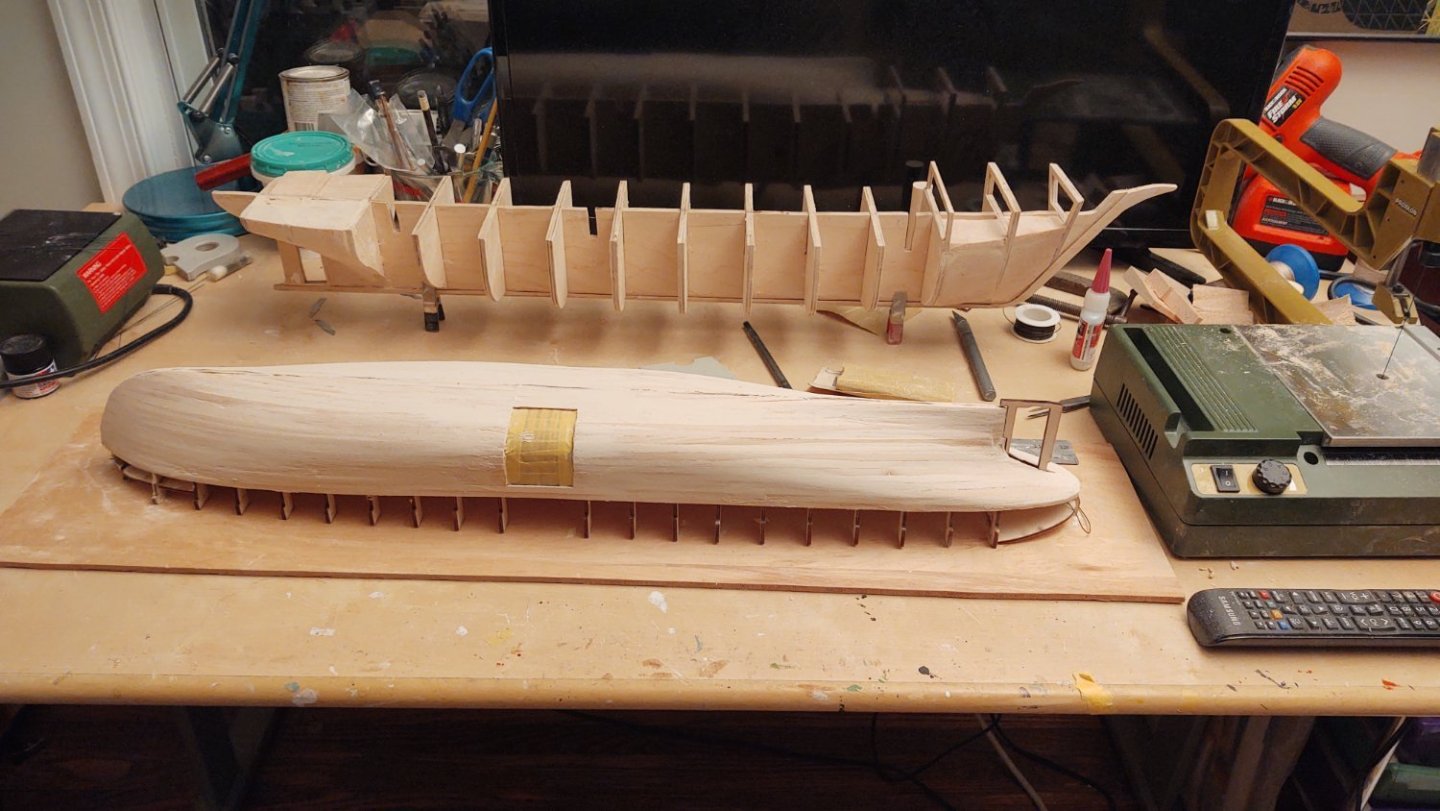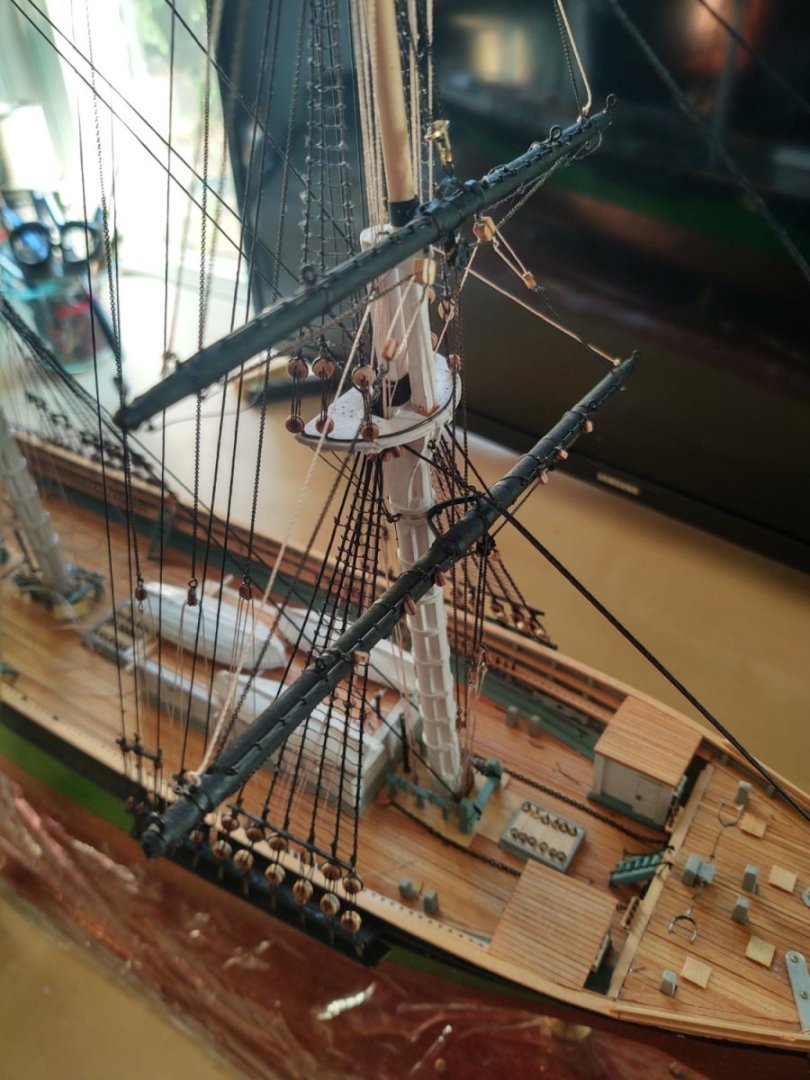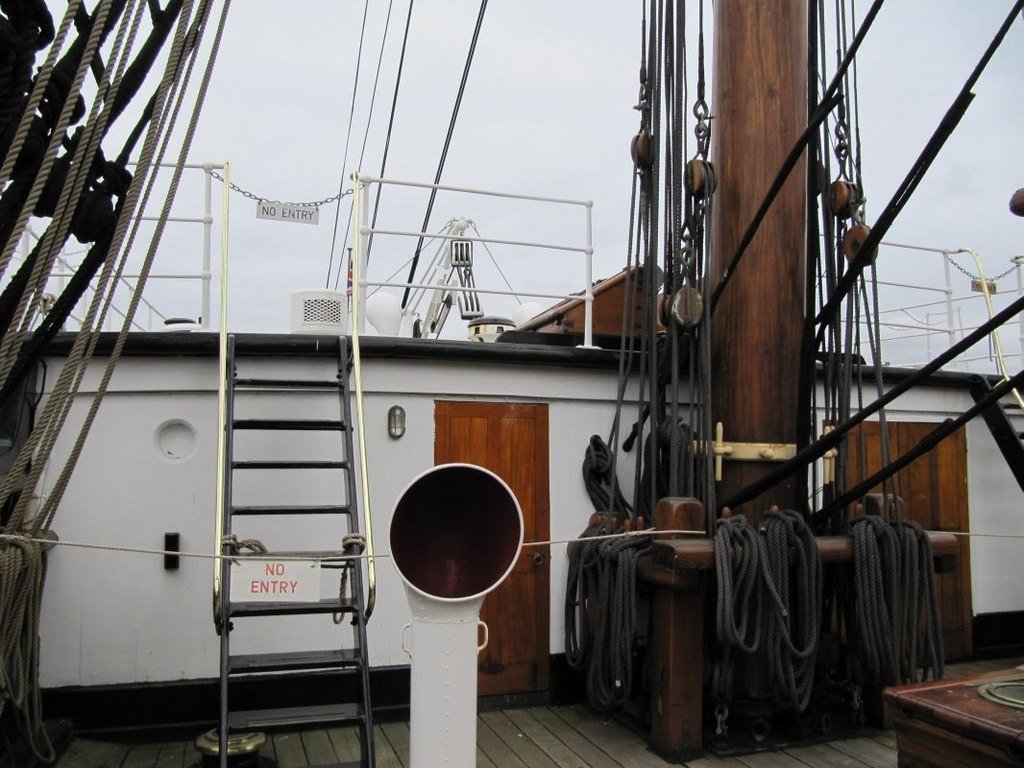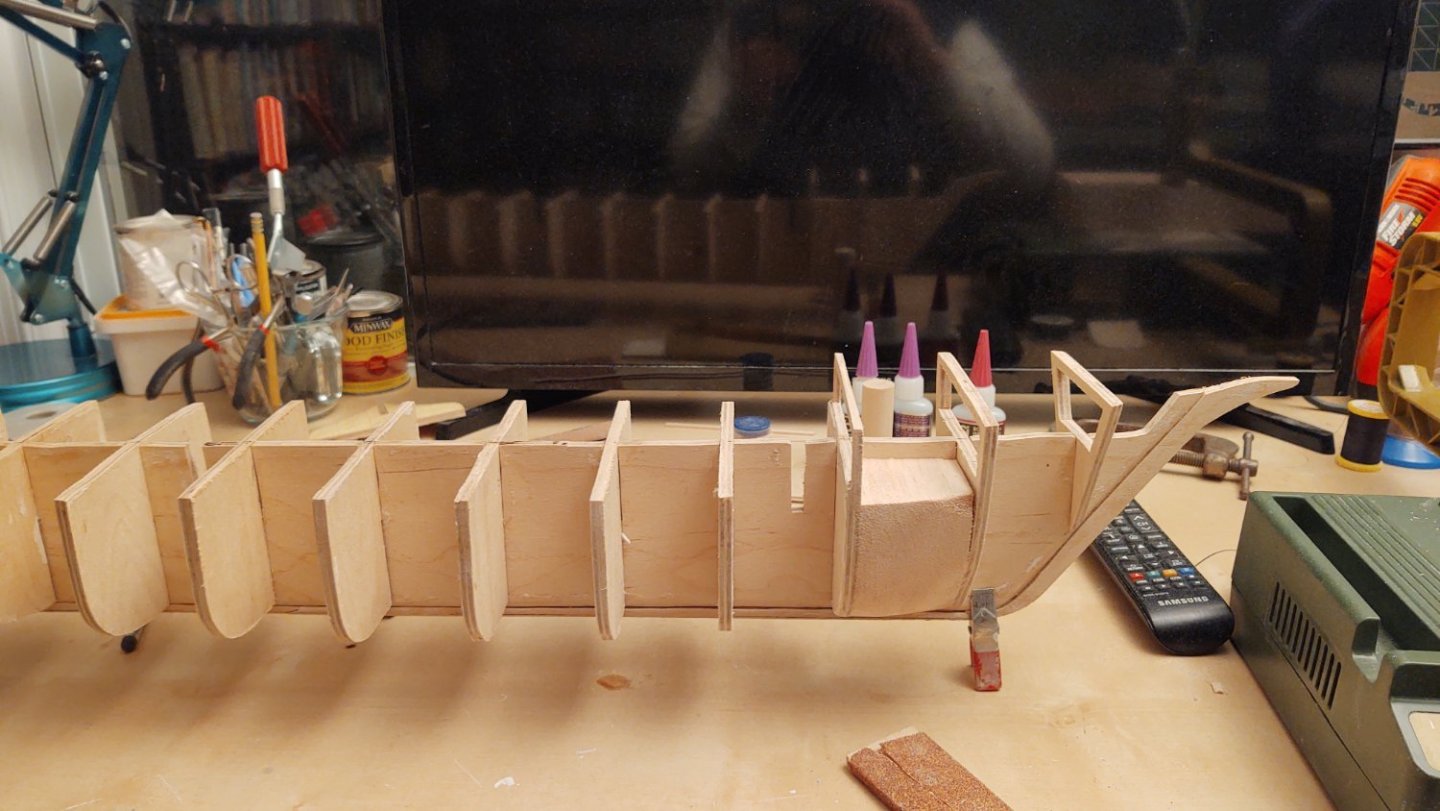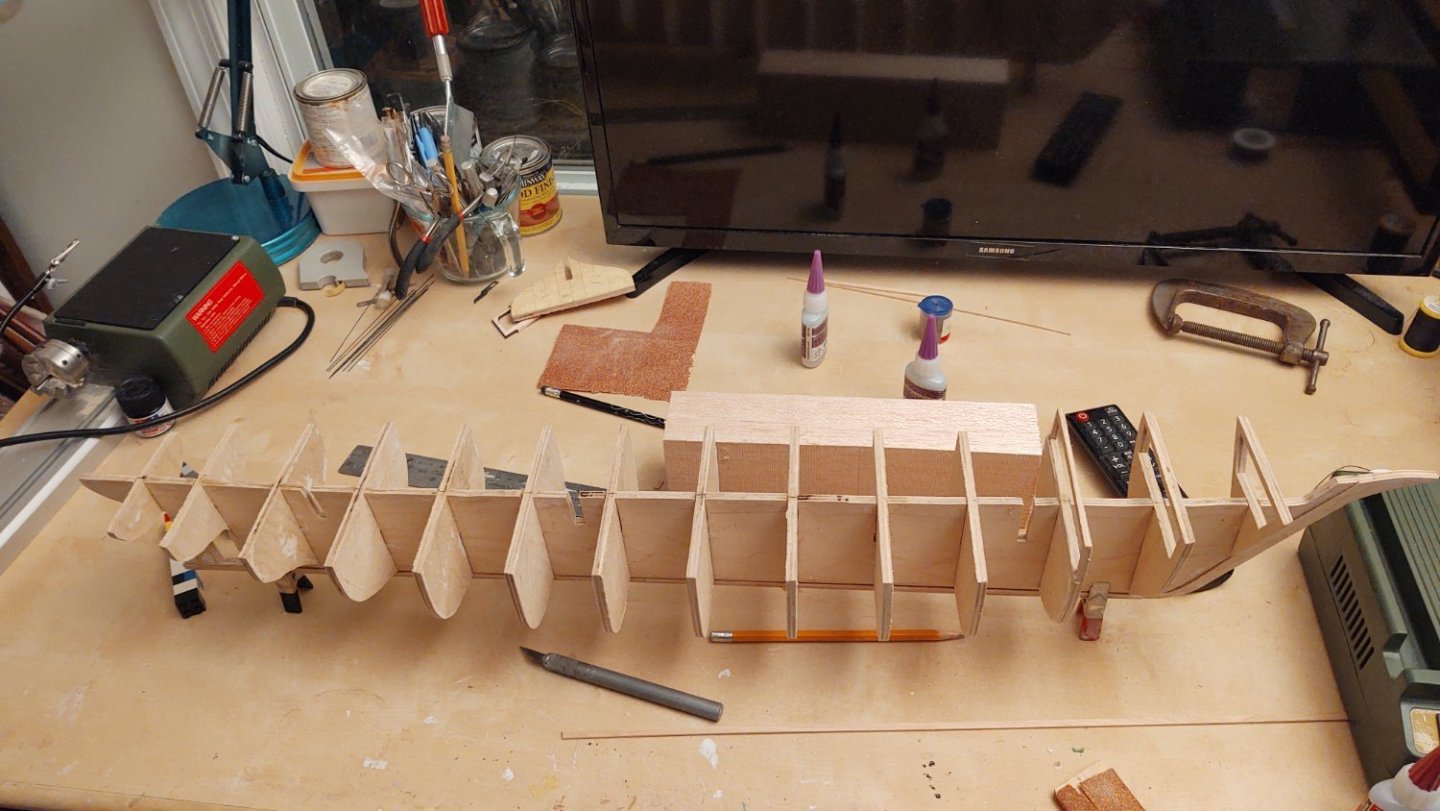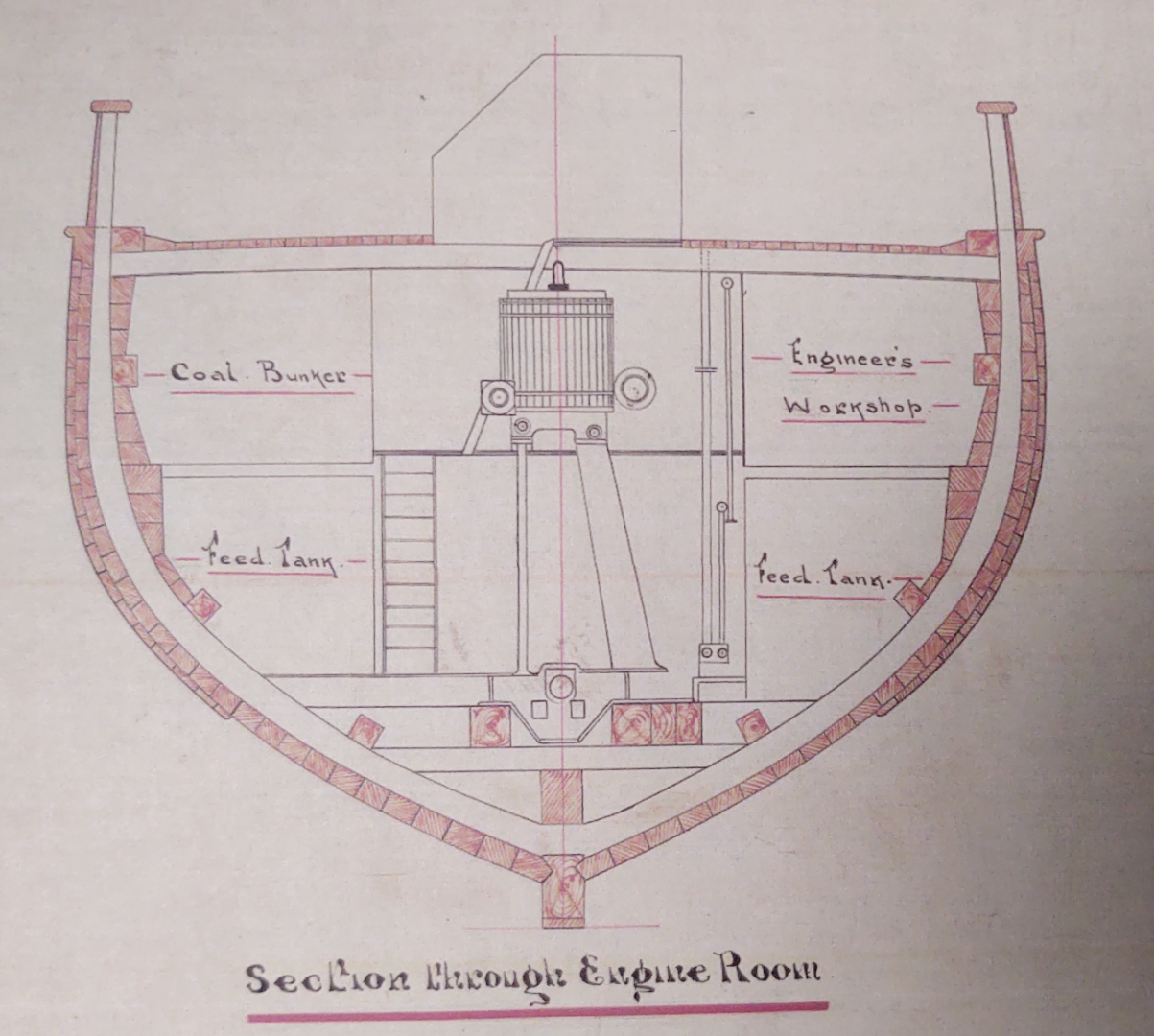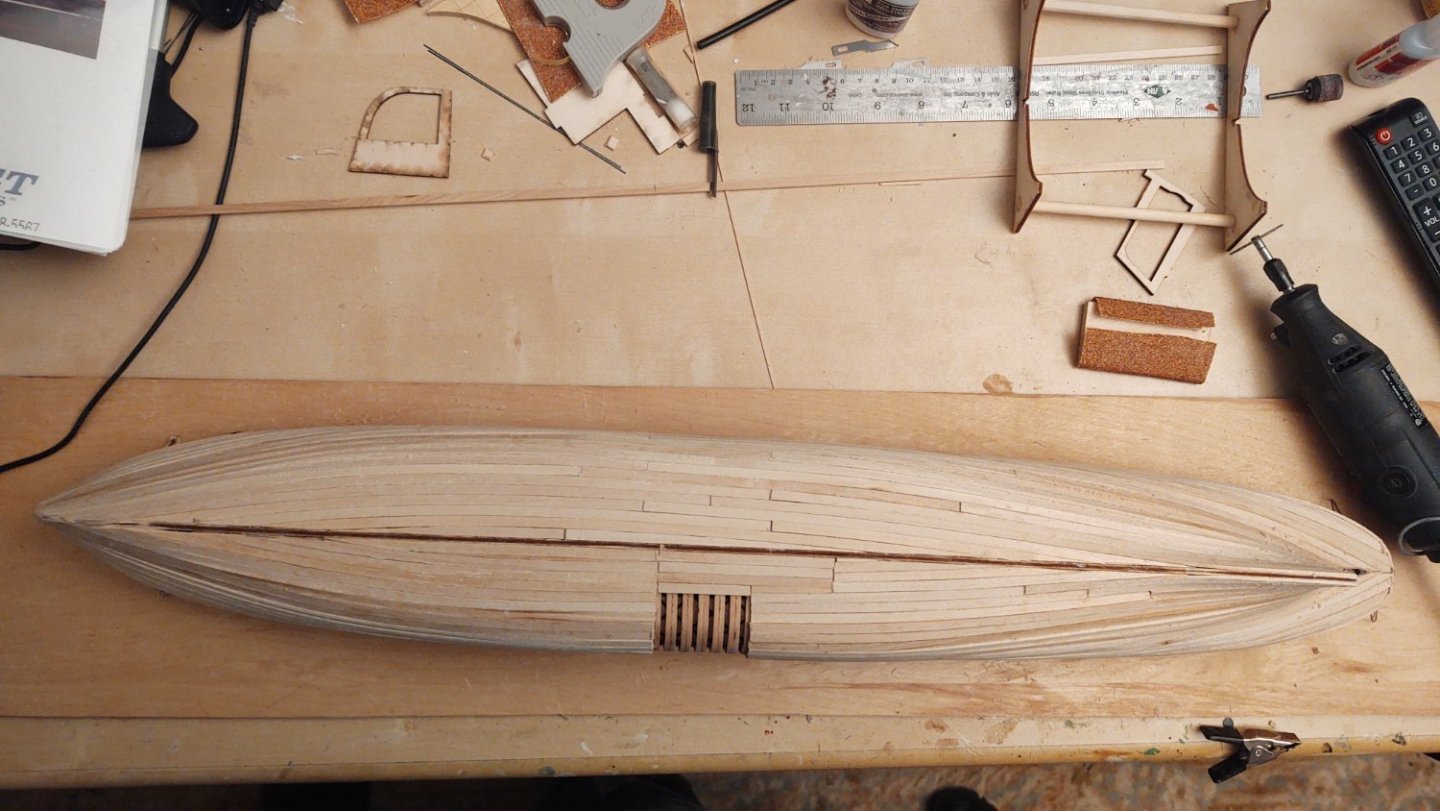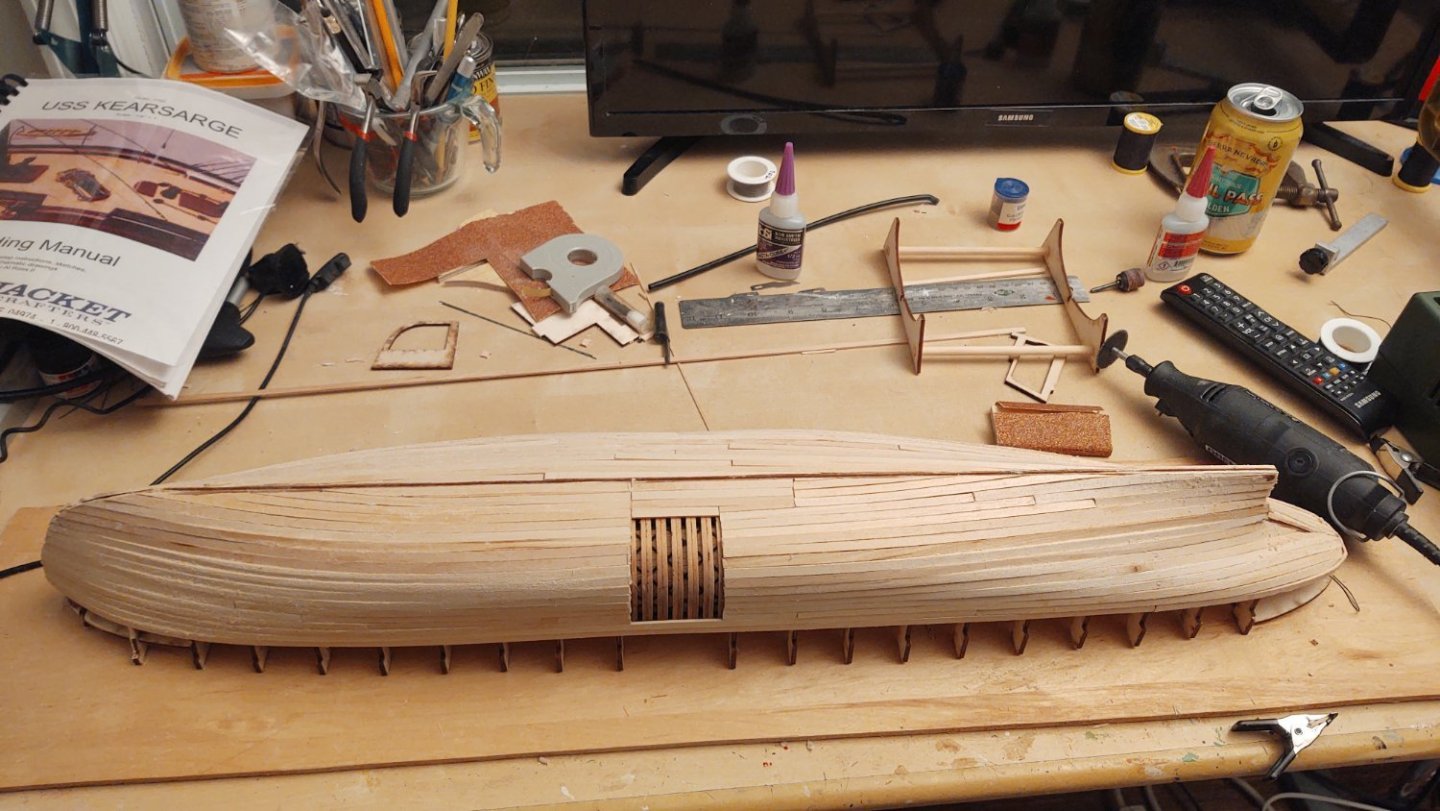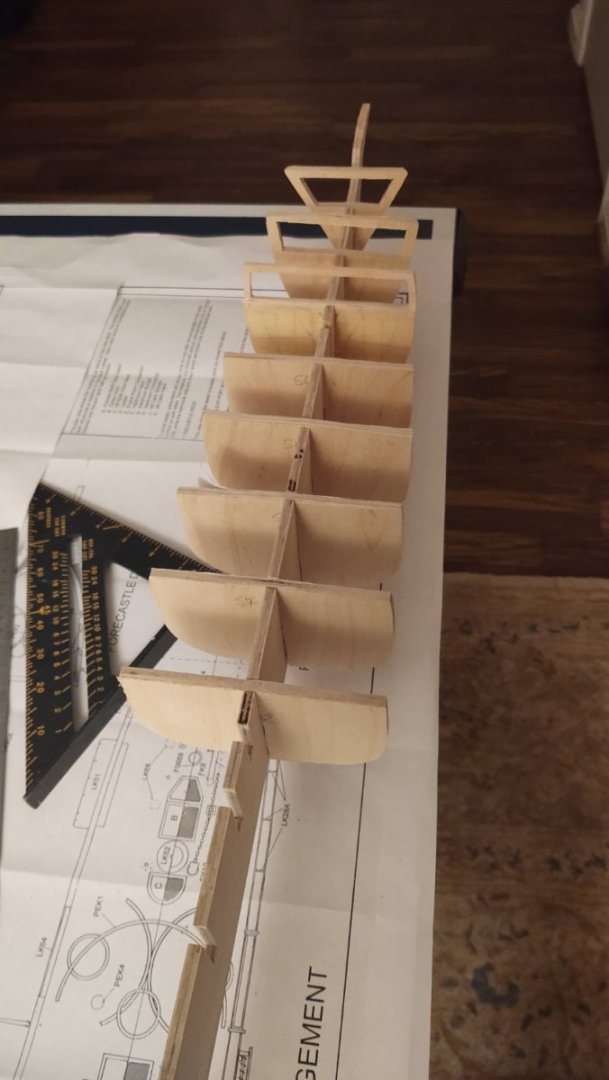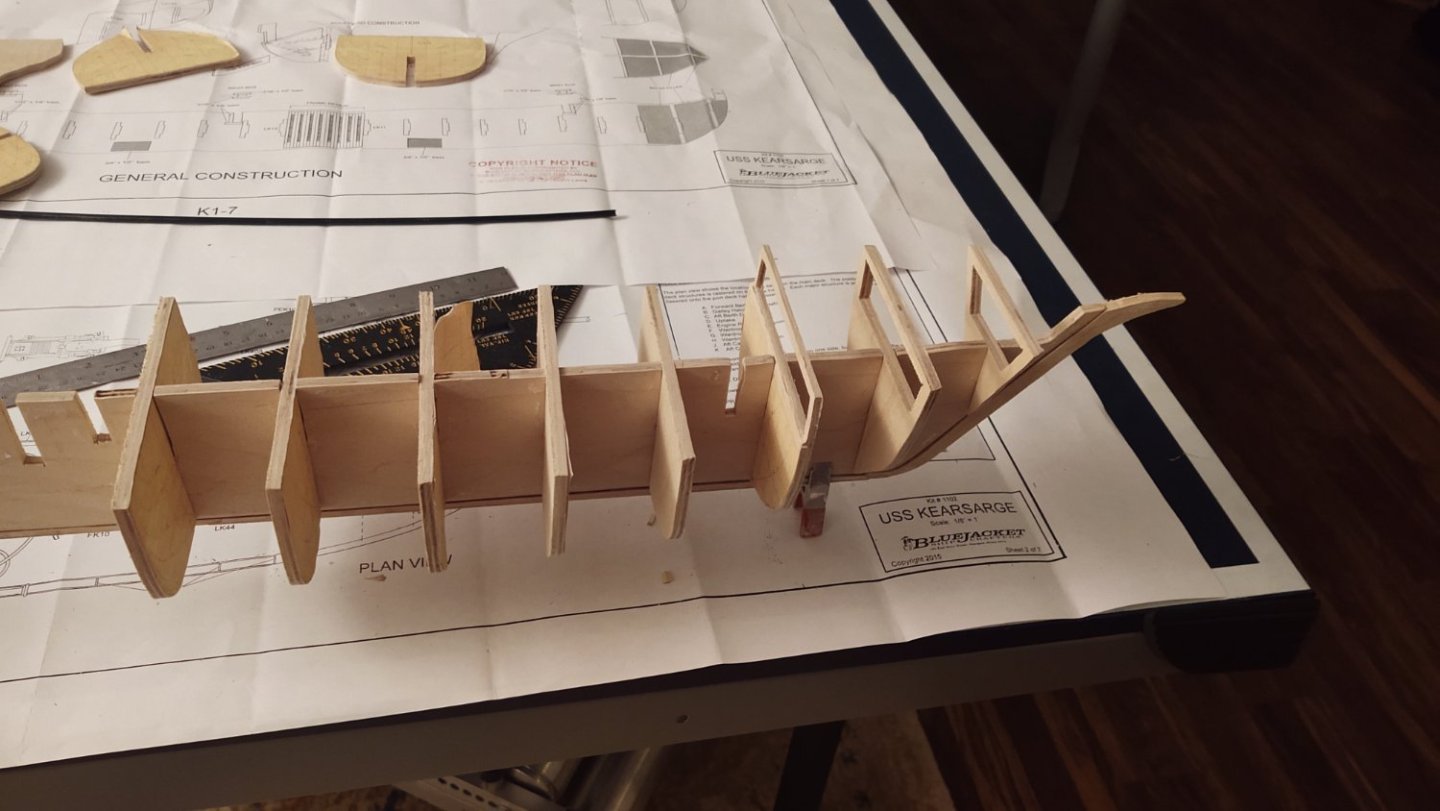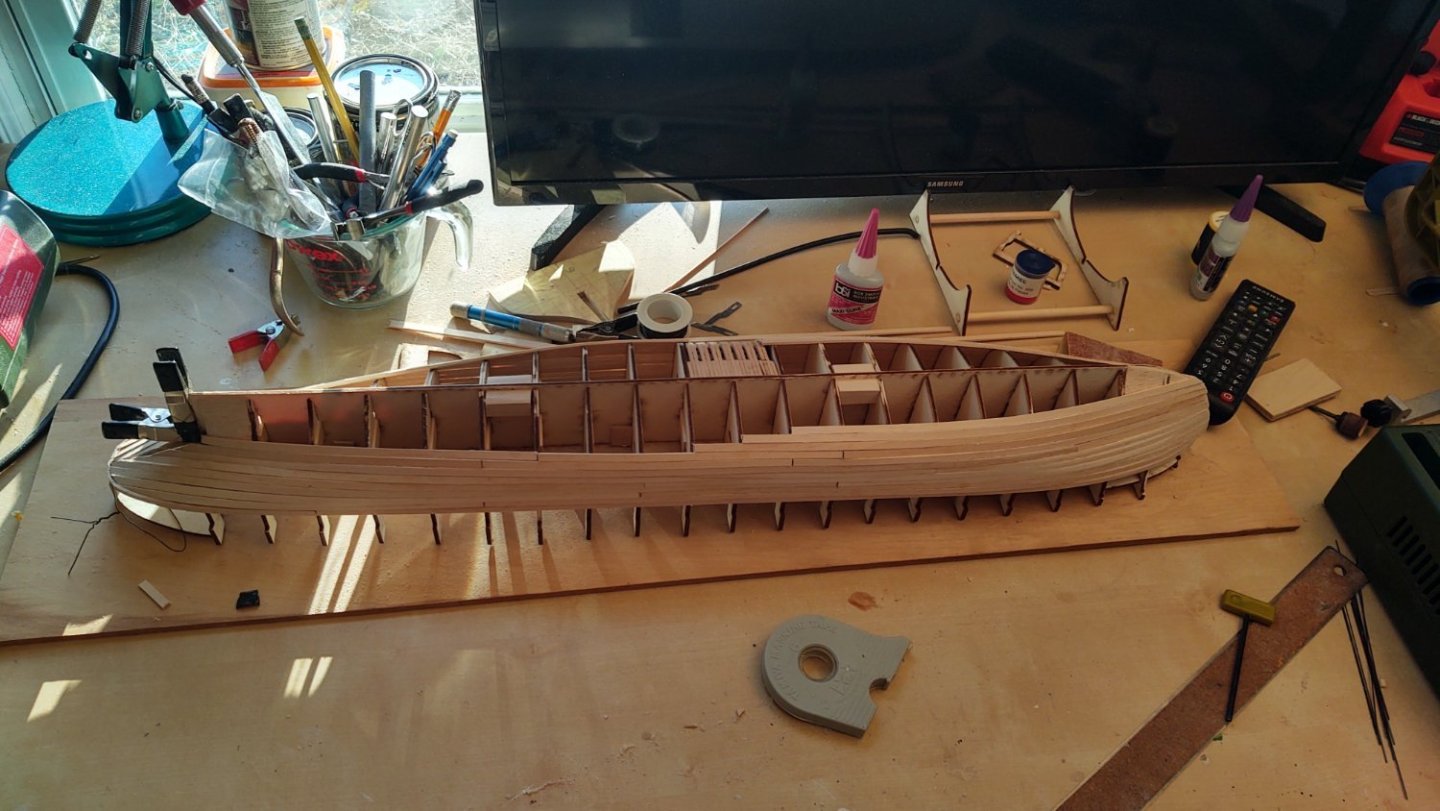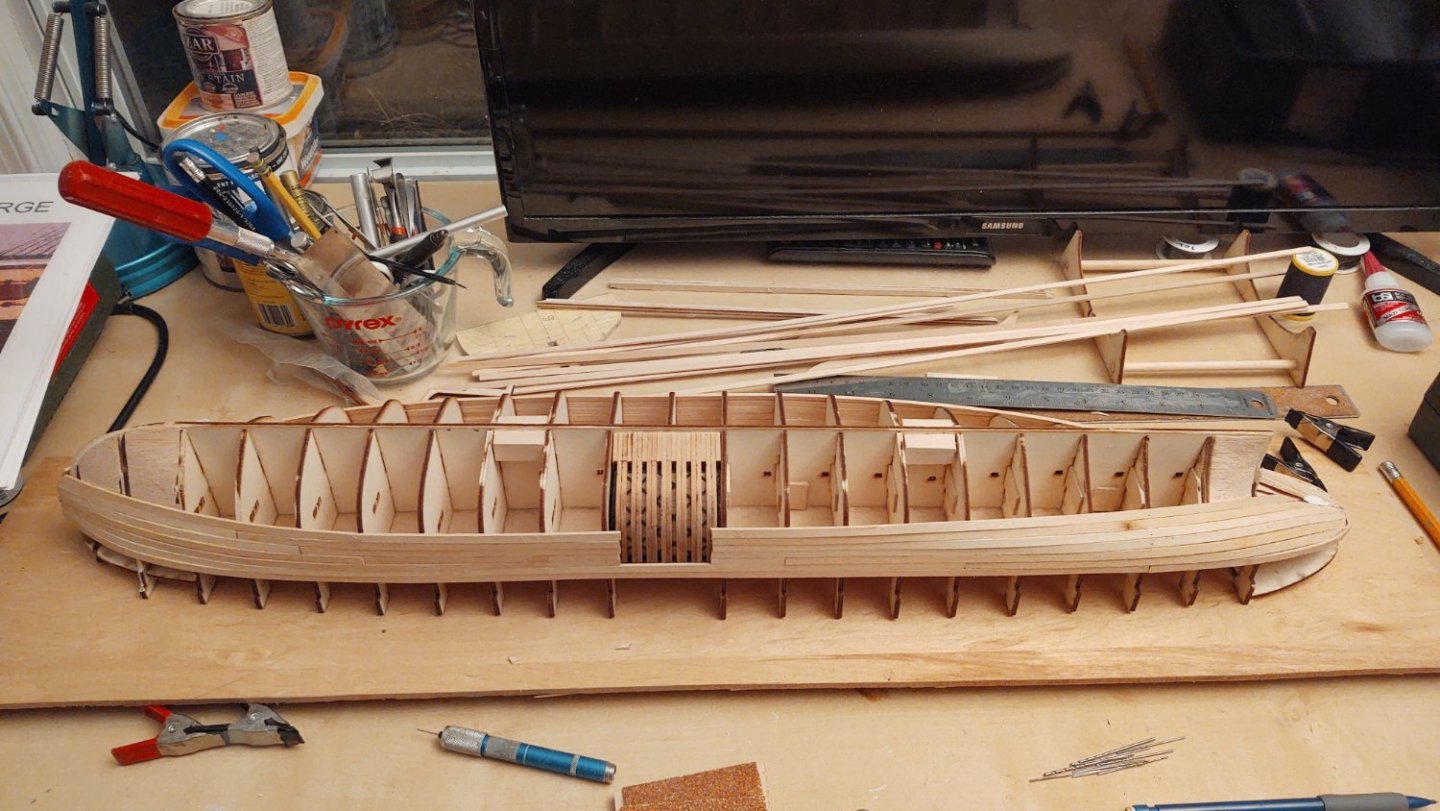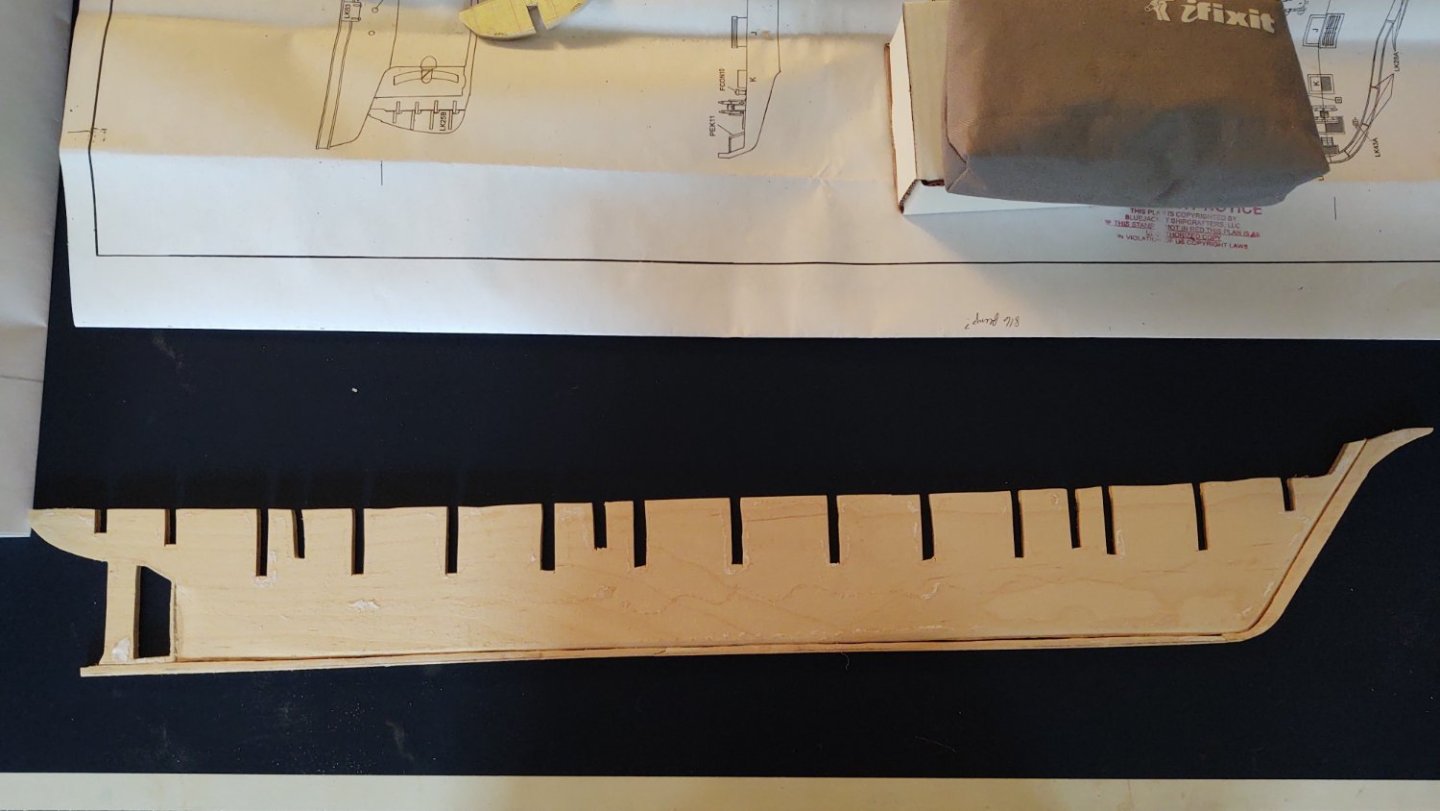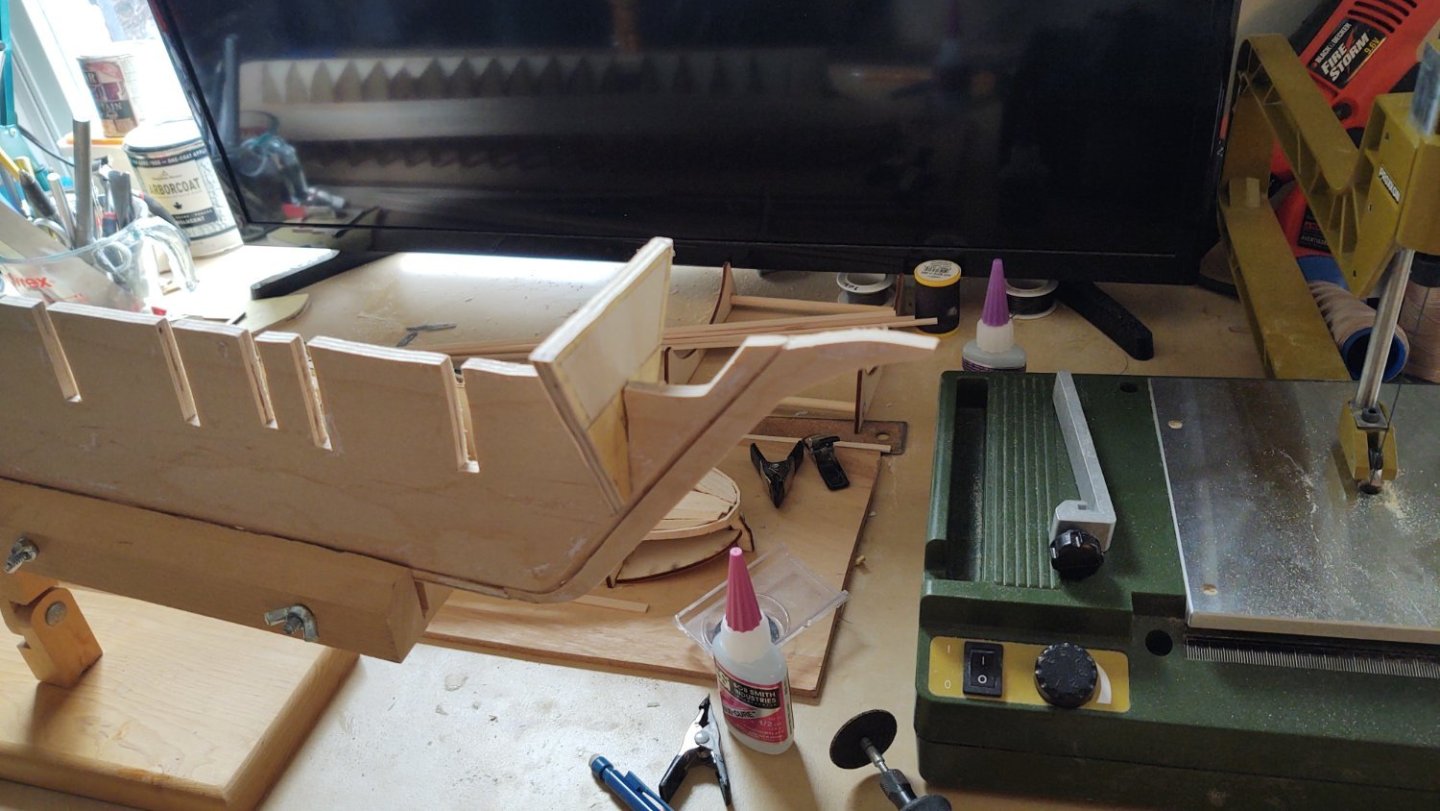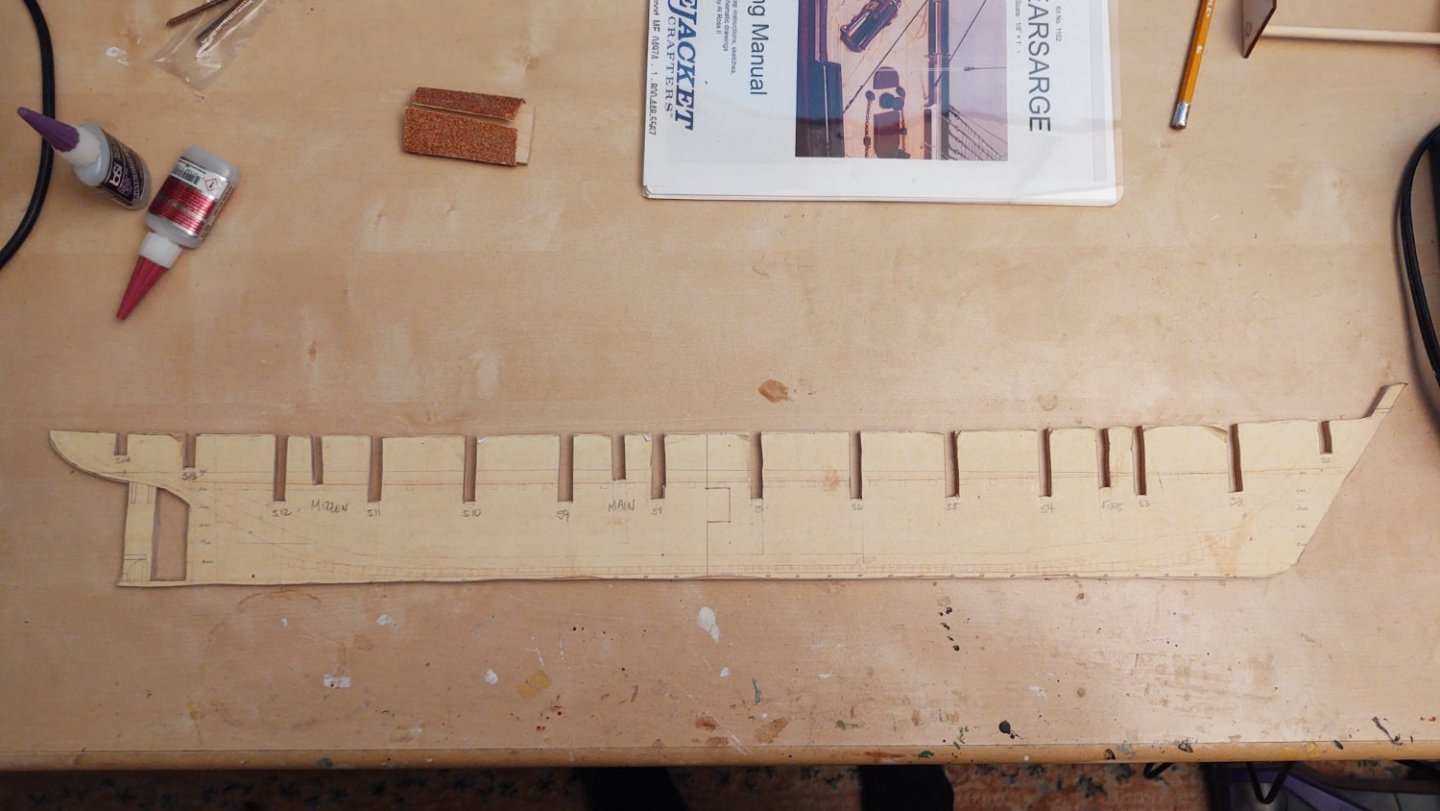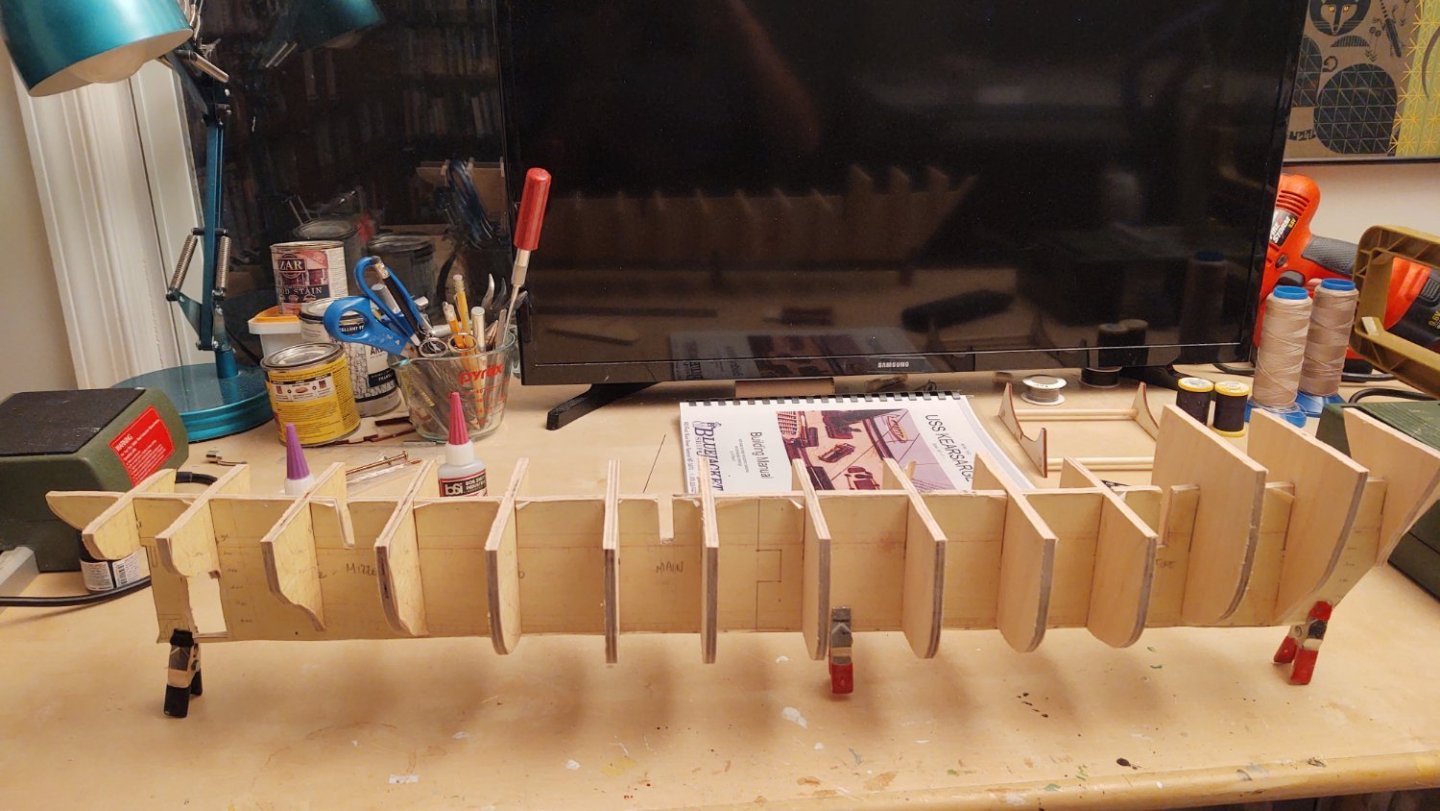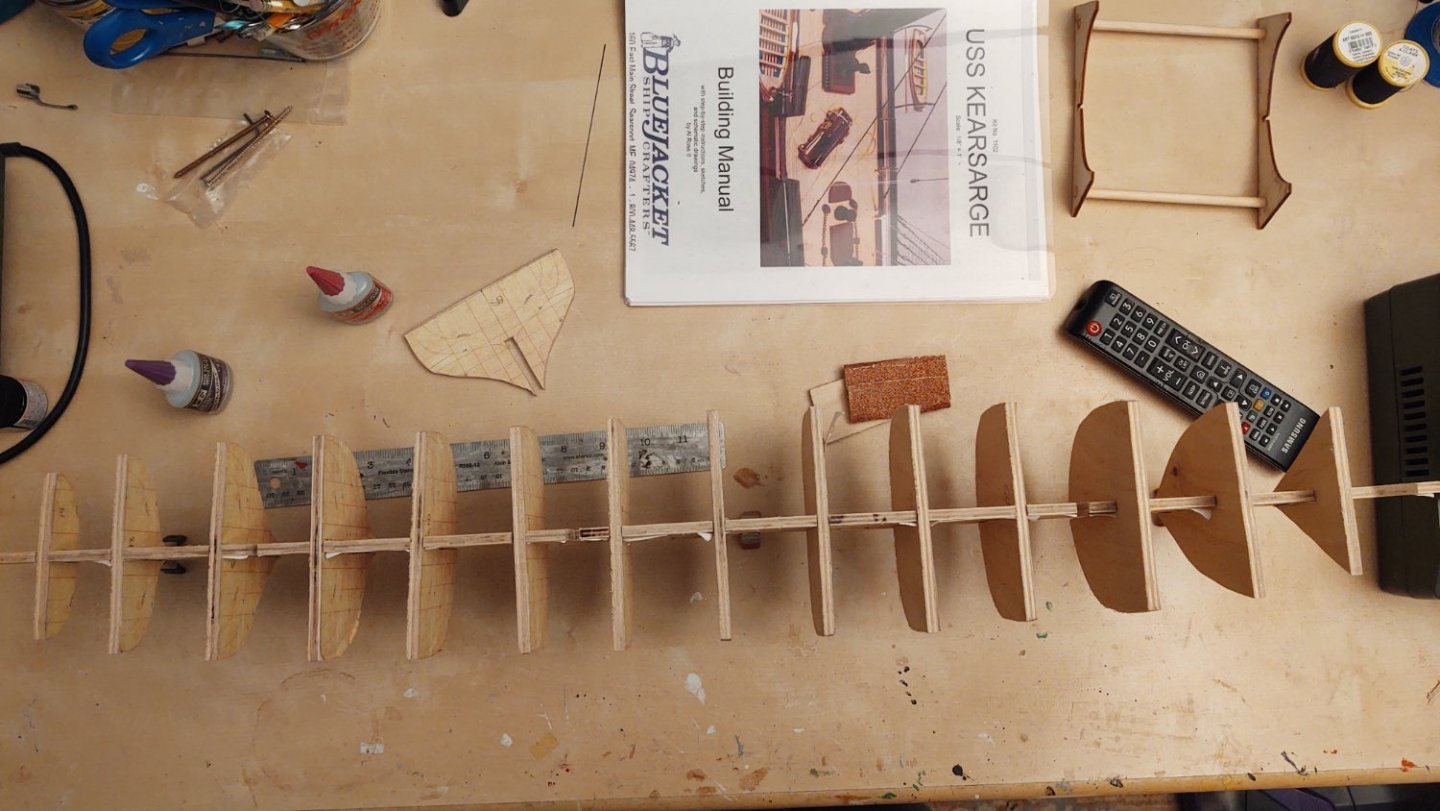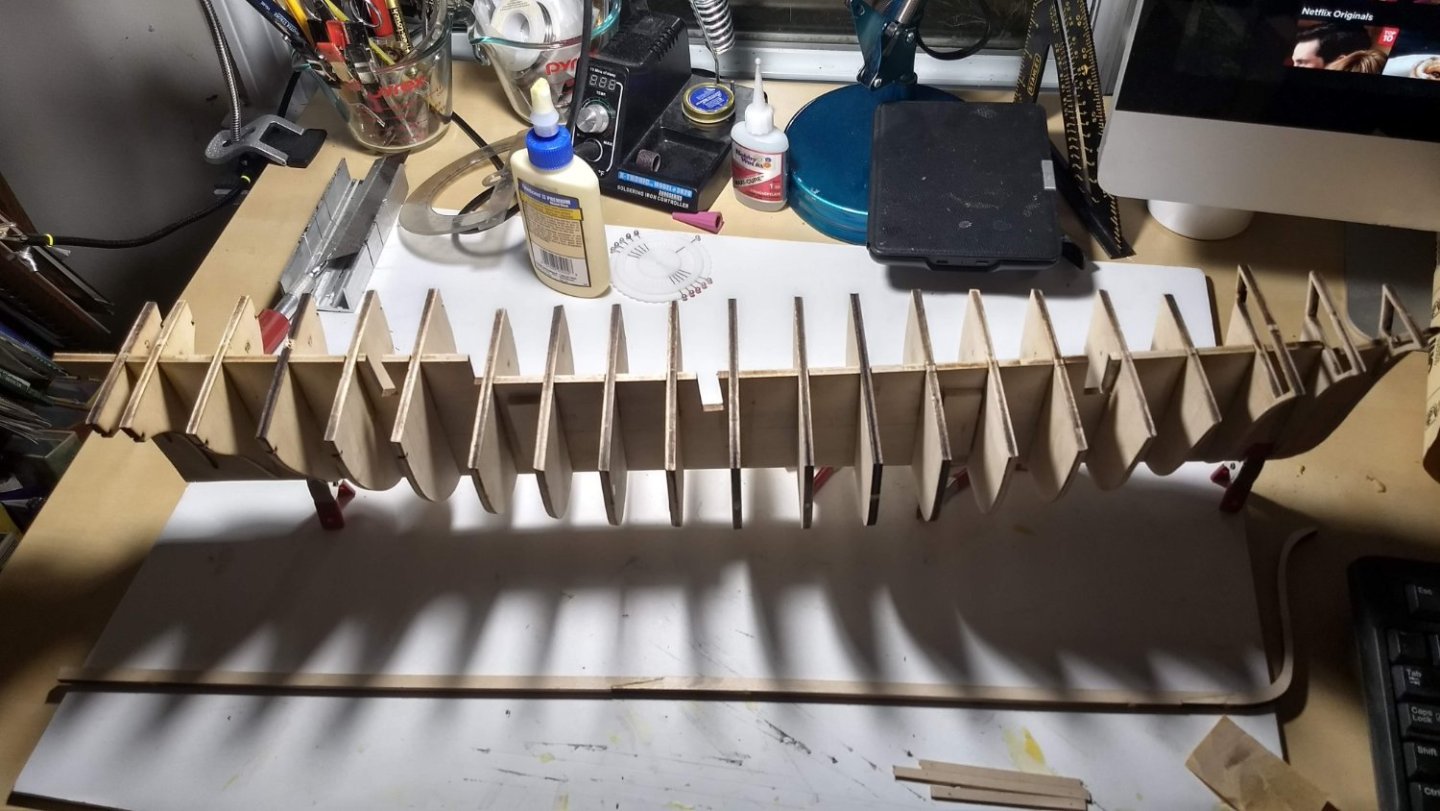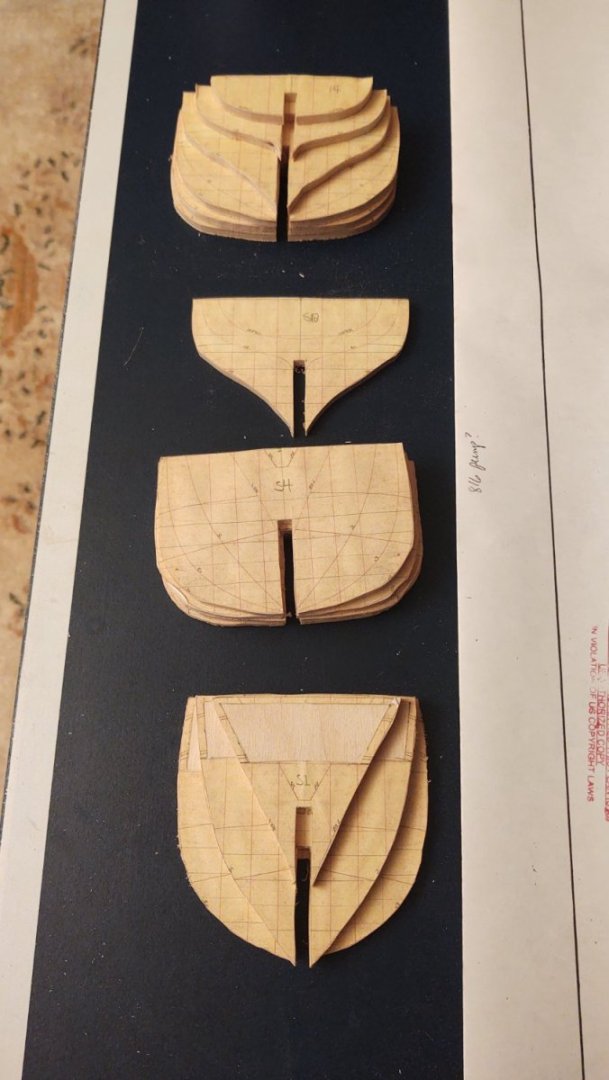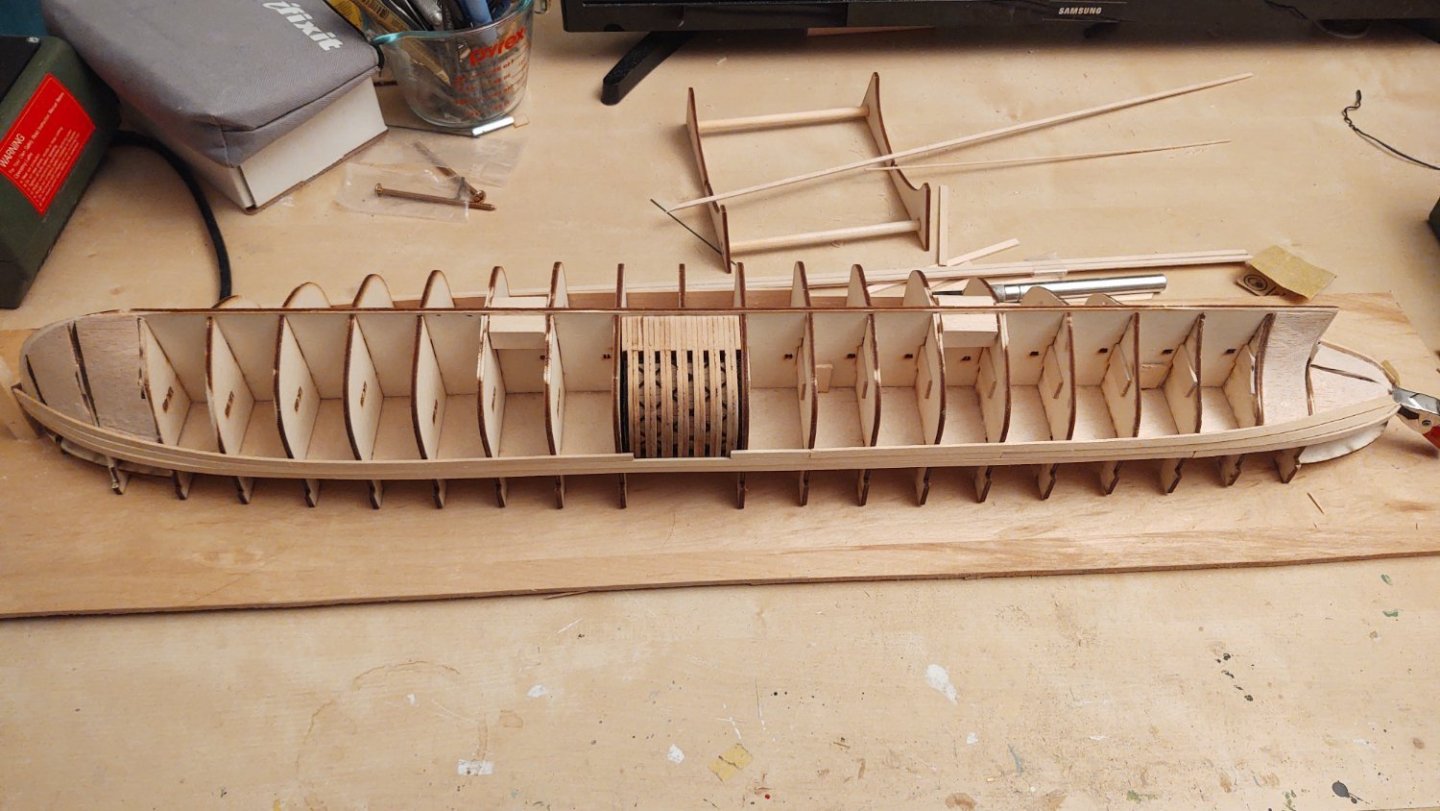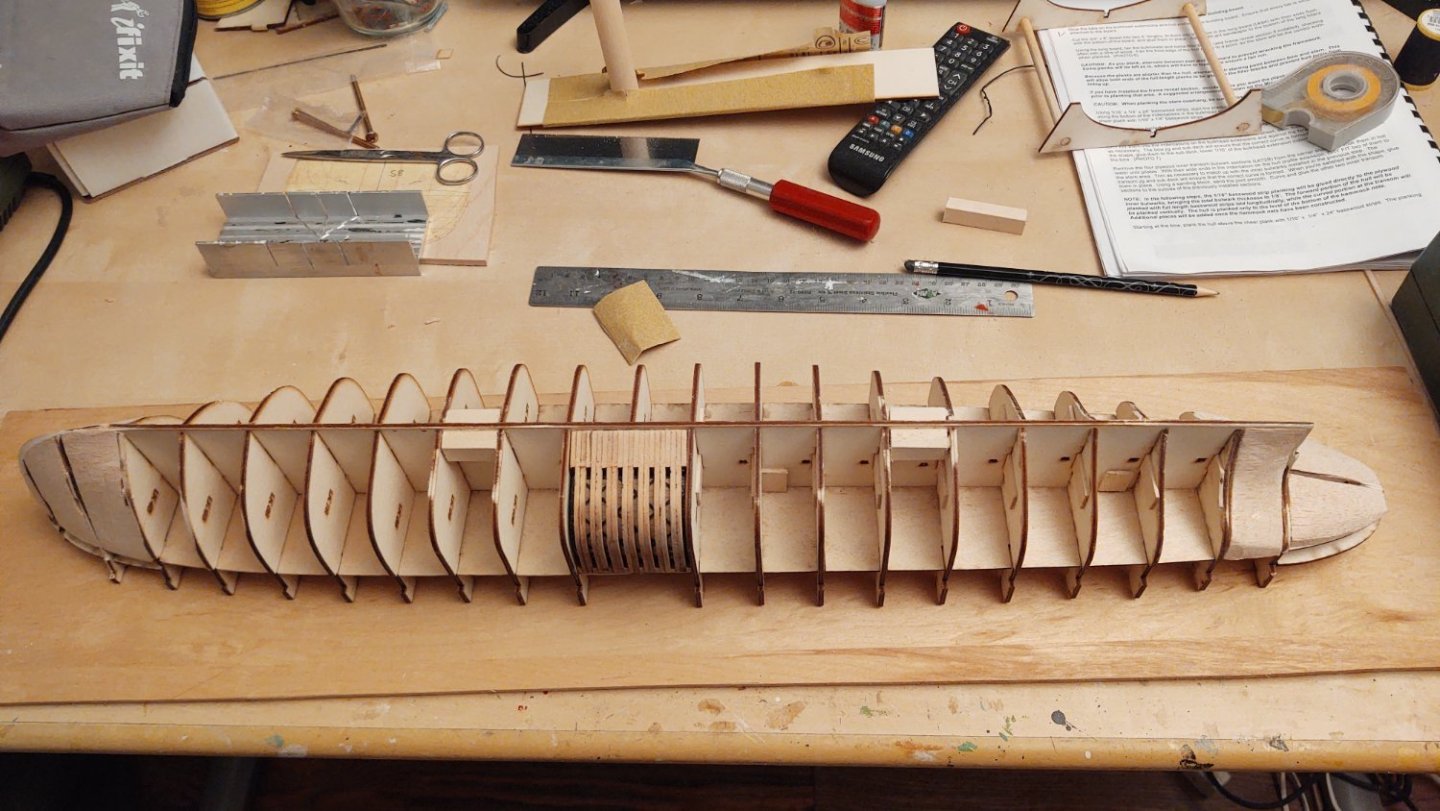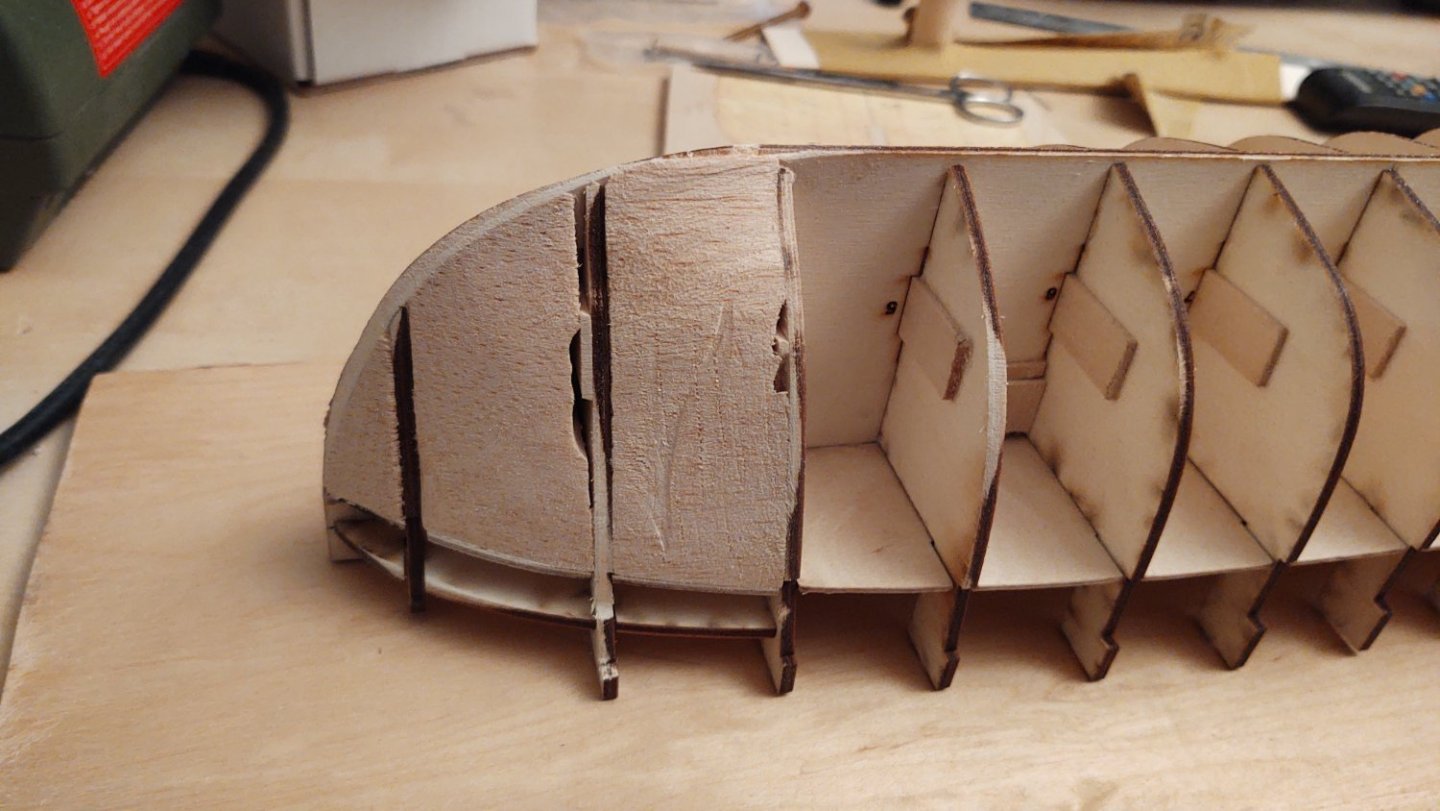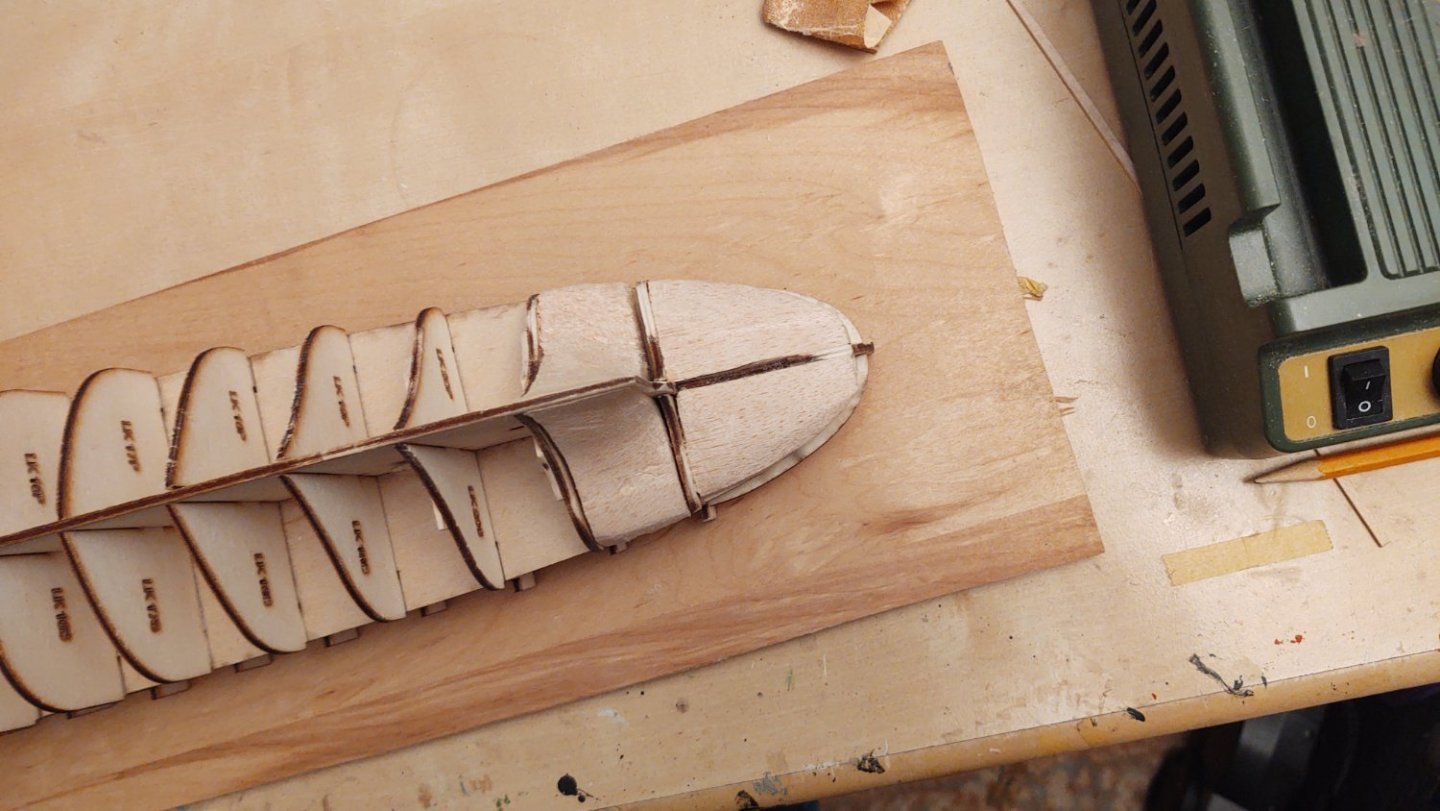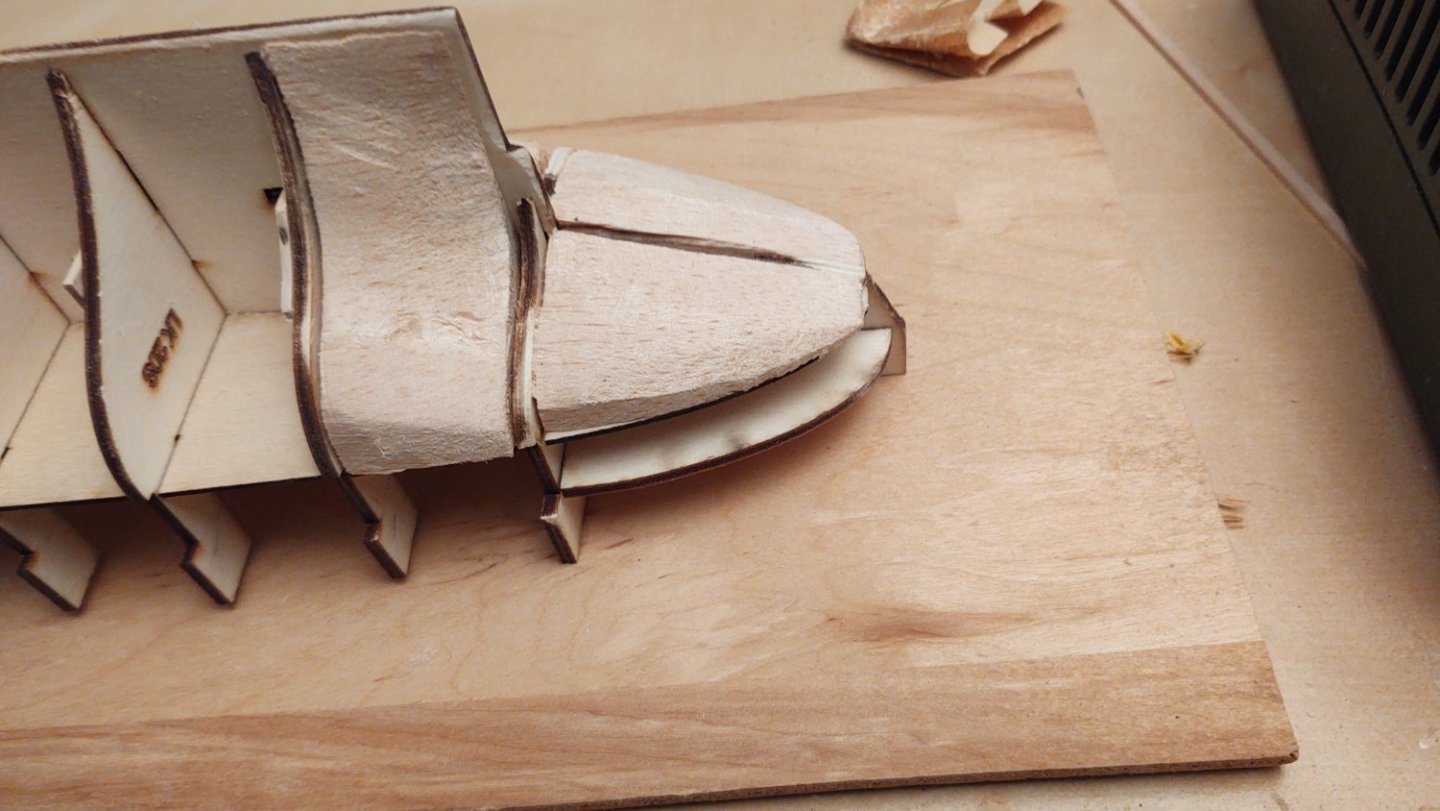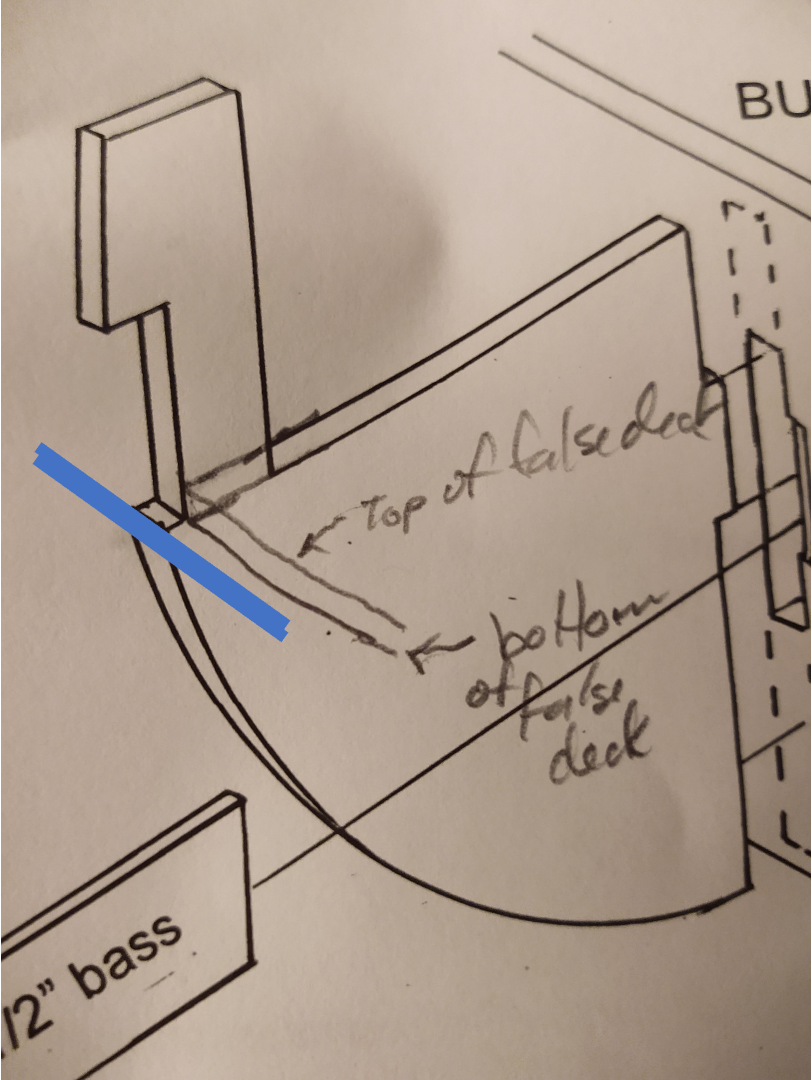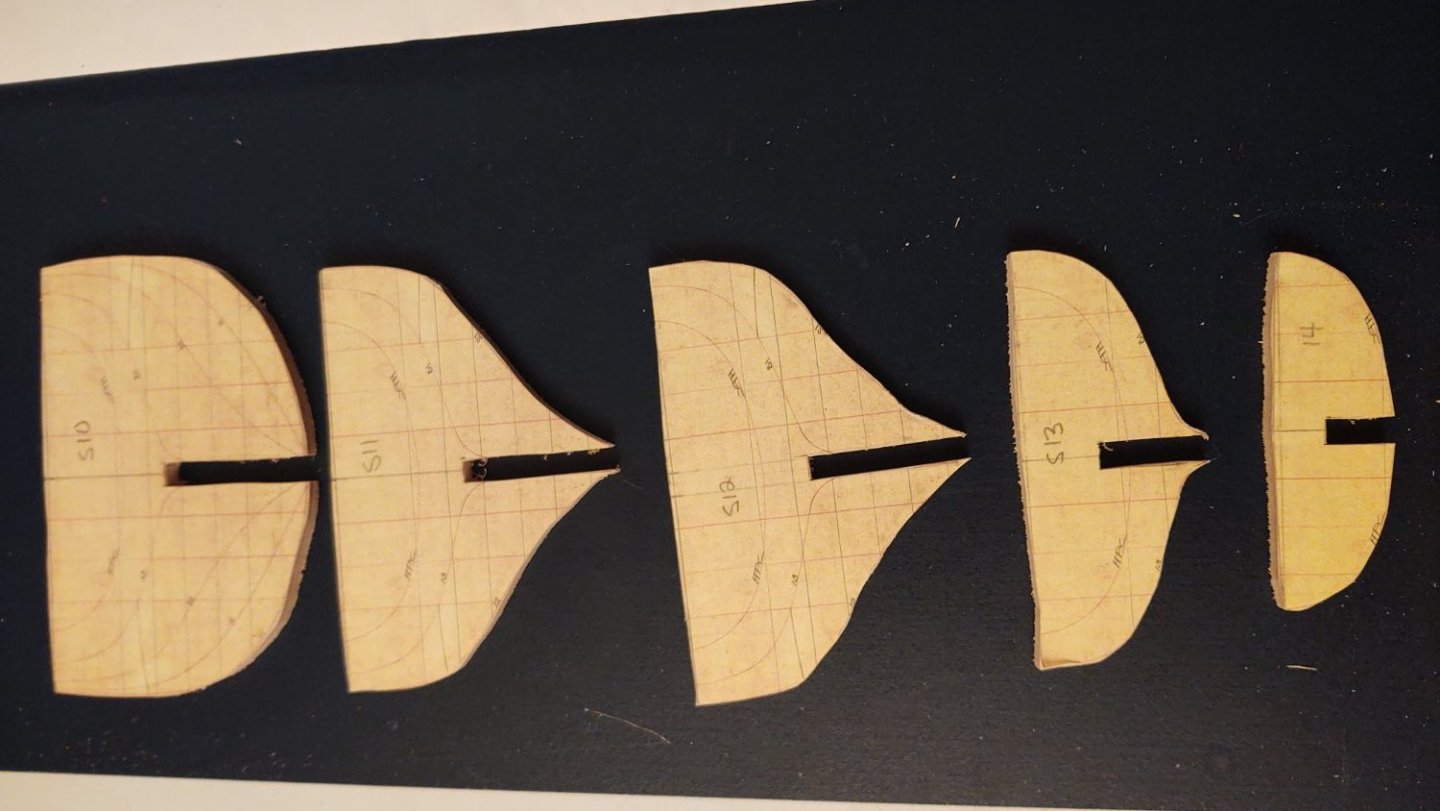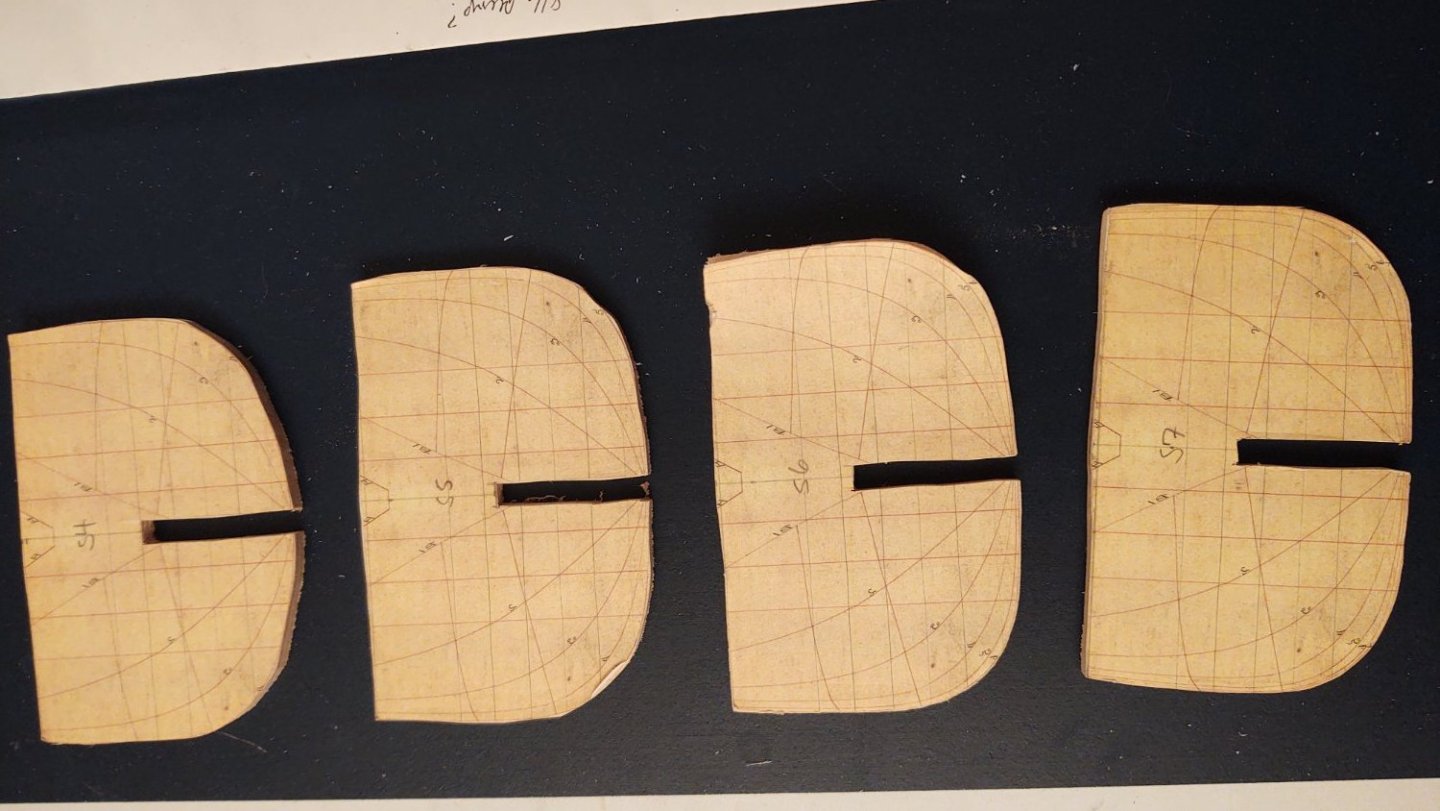-
Posts
715 -
Joined
-
Last visited
Content Type
Profiles
Forums
Gallery
Events
Everything posted by gak1965
-
I wonder if this will prompt calls to have tugs nearby when any ship goes under some of these crucial bridges. MV Dali was registered at 116,000 DWT and was almost as tall as the bridge itself, nothing like the ships that were being used (or even considered) when the bridge was being designed and built. It's not even clear to me what exactly how you would engineer against a quarter of a billion pounds of anything striking a pier.
-
Thanks Rick! So, completed the coarse preparation of the main hull, a bit of putty and some 150 grit sandpaper. It will need more, but I think it's good enough to start putting the inner bulwark pieces in. Once they are planked, I can do a much better job getting the hull ready for paint. The really good news is that I am going to copper the bottom rather than paint it, so any imperfections will be even more hidden. In the photos below (with the frame for the RRS Discovery in the background), I've dry fitted the rudder post, it will come out before the next step. So, starboard side: and port side: One observation. I went looking for the relevant pieces for the inner bulwark. The two main pieces were easy to spot. They are LK72(A) and there are two of them. The pieces for the stern are LK72(B) and there are 4. What surprised me was that, on the same sheet, right next to LK72(A) were 4 pieces marked LK27(B), and I couldn't figure out how the heck I was supposed to use them to build the stern. Of course, they were the wrong pieces (I had swapped two digits) and when I saw the actual LK72(B)'s (which are half the thickness and hence on a different sheet), the whole thing made sense. With that said, if BlueJacket ever revises the instructions, they might consider including a diagram or photo of how these pieces work. Thanks for looking in and for the likes! George
-
Well, @MrBlueJacket's adage that "putty and paint make it look what it ain't" seems to be starting to come true. I've put the four starboard side balsa inserts in and faired them. The aftmost is going to be made from basswood since it is going to define the stern's curve. At this point I need to go to the hobby shop and get some more balsa, that chunk didn't go quite as far as I expected. But starting to look like a ship. Thanks for looking in! Regards, George
-
The mizzen has only a spider band, no fife rails, which is consistent with a lot of other ships I've seen. I'm not sure how I would interpret the spider bands on the fore and main (they are both there, BTW). The original builder's plans show the fore and main fife rails and no fife rail on the mizzen, so I'm confident Discovery had them from the beginning. The ship didn't carry that much canvas in 1901, so why they would need both is a mystery to me. That said, the current ship's rigging is vastly different than during the 1901-1904 time period, though. The fore and mainmasts were moved 4 and 8 feet forward to their current locations in 1923; the current ship carries 5 yards/square rigged mast (vs. 4 in 1901), the bowsprit now has a jibboom that wasn't there then, etc. Wasn't there in 1901 (possible, looking for photos that would answer the questions)? Belt and suspenders? Maybe the sailors found the spider band more convenient but no one wanted to yank the fife rails? Someplace to anchor the extra lines associated with the split topgallants that were added? Your guess is as good or better than mine. Regards, GAK
- 205 replies
-
- Endurance
- Shackleton
-
(and 2 more)
Tagged with:
-
Hi Tom, Ship is looking great. This was like 8 weeks ago, but I'm interested here because I'm doing a scratch build of RRS Discovery and I have the same issue in that the plans I have are good for the standing rigging, and the location of the running rigging on the masts/yards, how they are anchored isn't shown. I am going to see if there are other plans at the Maritime Museum (I only had a couple scanned b/c it was expensive) but will let you know what I learn about how Discovery was rigged if you are interested. Two thoughts. First, as to the sheet's and halyards that are nominally tied to an eyebolt surrounding the masts, that seems odd to me. For the square rigged mast in particular, I would expect a ring of eyebolts that was the deck location of the tackles that go to the sheets/halyards/live lifts, but the live end of the tackle would end at a pin on a fife rail or on the mast. That is how the Flying Fish is rigged (see photo below). Not the best photo, but you can see the tackle that is attached to the sheet chains. Discovery is rigged the same way. You can see the tackles and the live ends on the fife rail of the foremast. Now, you need to be careful over interpreting - Discovery had her rig changed many times over the years (heck the masts were physically moved in the '20s, but when I see this pattern over a span of 50 years I suspect it's pretty common. I've never heard of anything running attaching to the channels either. Again, I've seen examples of tackles being attached to the channels (e.g. royal and skysail halyards) with the live ends of the tackle attached to a pin on a pinrail on the inside bullwarks. FWIW, Discovery has a continuous pinrail that runs along the length of the bulwarks, with periodic holes for pins. My suspicion is that lines that were belayed at the bulwark were belayed where convenient and not according to some unalterable master plan. Regards, George
- 205 replies
-
- Endurance
- Shackleton
-
(and 2 more)
Tagged with:
-
My local hobby shop nominally carries a pretty wide selection of basswood strip (Midwest is their supplier), but their actual stock is a bit sketchier. I was there over the weekend to buy some glue, and I figured I'd get the 1/8" x 1/4" wood I'd need for the waterways, but they had none available. I generally try to buy from local sources (this place is a 3 location local chain in the DC area) to help keep them viable, or at least buy from specialist online retailers that support ship modelers for the same reason. Maybe they can order what I need for me.
-
Yikes, it's been about 3 weeks since I posted an update. Part of that time I was away, and part of it was working on the USS Kearsarge, but some real progress. First photo, all of the frames are fared, their elevations evened out, and glued in place. Large chunk of extra balsa from the Kearsarge in the background about to become part of the ship. Second photo has the first of the filler blocks in place and (mostly) faired (final fairing needs all the fillers). It doesn't go to the top of the bulkhead at this moment because I'm trying to efficiently use the balsa block I have handy - I'll fill the rest in with leftover chunks. I'm imaging 8 or 10 balsa fillers at the moment (between bulkheads 2-4 and either 11 or 12 to 14. From 14 to the stern I'm going to make the filler blocks out of basswood, and for the prow to bulkhead 1, I'm going to make a basswood filler that includes the knightheads. The ship gets two sets of planking (as seen in the section below). The inner, thicker set where the planks average out to about 2mm (1/16 to 3/32") deep by 3mm about (1/8") tall at scale, although the actual thicknesses vary a bit, and an outer layer over about 2/3 of the hull that is about 1mm x 3mm at scale. The model will be pained, so, presumably I'll use basswood - it's cheap(er), it bends well, and it doesn't have to have beautiful color or grain. That said, can anyone recommend a wood source? The only sources I know of with small dimensional lumber are ModelExpo and BlueJacket. Do you all find one superior to the other? Is there someplace else people would suggest? Any input appreciated. I'm on the US East Coast if that matters. As always, thanks for the likes and for looking in. Regards, George
-
FWIW, I used 24 gauge annealed steel wire for the jackstays on my 1:96 Flying Fish, except on the skysails where I dropped to 34 gauge. Doesn't mean it's right or to scale, but it seemed to look okay and worked tolerably well with the 0.75 x 6mm eyebolts I used for the jackstay eyebolts. Regards, George
-
Mike, Glad you are back. I described what I did in this post: The summary is that I ran the forestays through the relevant locations (bees or hole in the jibboom) and the dolphin striker (if relevant) and then fed it through a hole I drilled in the bulwarks. At each location where the lines changed direction, I put a drop of CA glue to hold it in place, so that by the time I got to the hole in the bulwarks it would stay taut without having major strain on that one drop of glue (the line had 2 or 3 glue drops holding it in place. My recollection is that I ran enough line through the hole that I could snag it with a tweezer and hold it tight while the CA set (maybe 30 seconds). It worked for me, buy YMMV. Hope this helps, George
-
Thanks Keith, appreciate the confidence! I'm heading off on a work trip followed by visit to my daughter in Boise, so last update for a couple of weeks most likely. Bulkheads 1-8 are rough faired, evened out, but not yet glued in place. As you can see I opened out the fo'c'sle after all. I don't anticipate adding ceiling planks in there but the foremast has a set of forestays that anchor in there (through holes in the bulkhead so I just cut them out. One thing that may not be obvious is that in bulkhead 3 I thinned the part above the center keel to 1/8". The reason is that the fo'c'sle starts about 1 ft ahead of the station line in the drawings, so I needed to adjust accordingly. As always, thanks for looking in! Regards, George
-
Any of the Brunel designed ships. Great Eastern, Great Western, or Great Britain would be cool. And a plea for that humble Cold War workhorse, the Spruance class. I'm partial to Peterson (969), but any member would be fine. It would joun your other USN DDs and you could make 2 variants, pre VLS and post VLS mods. And heck, build a Ticonderoga from the same hull, and several of the later (VLS variant) Ticos were built in Bath. George
-
Well, this feels like a bit of a milestone. Center keel cut. I drew lines to split it into two, but I was able to do it as one piece by cutting a bit of the center with a razor saw and some 80 grit sandpaper. So here is the keel with the pattern still attached: Here are two views of the bulkheads, from the top and side, dry fitted into the center keel: They still need to be trimmed and faired, some of slots lengthened and maybe one shortened, the bearding line needs to be put in, frame 3 has to be thinned above the main deck so that the forecastle will be properly aligned, filler blocks are needed fore and aftand I still have to cut out the keel. But, the thing is starting to look like a ship. Not radically different looking than the Flying Fish at a similar point in the journey: In any case, thanks for looking in and for the advice! Regards, George
-
Heck oil firing can be messy. My recollection is that the reason most US naval vessels had black masts and funnel/uptake vent tops until the '90s was that they would get that color anyway.
- 393 replies
-
Well, a brief check in. I did get my saw set up better, proper tension on the blade in particular. I also learned that I was breaking the blades when I was making straight cuts removing pieces from that large piece of ply, and realized I was pushing harder on the blade. I'm using a very fine blade (34 teeth per inch) and I think it just needed to go slower. When I am cutting out the pieces, I'm much slower to make sure that I don't over cut - and so once I realized that my blade problem more or less went away. Here are the bulkheads as of today (no real smoothing or fairing). I thought I had all 14, but then I realized that I made 12 unique bulkheads, 2 of bulkhead 12 and none of bulkhead 11. So, one more to go before cutting out the center keel. I did take the cut out bulkheads and put them into the paper pattern for the center keel and they seem to fit properly, although several of them will require a non-zero bit of fairing due to their thickness. But that's okay - cutting them wrong would have been more of an issue. So here they are (I haven't cut out the forecastle yet. Debating at this point as it turns out that the Discovery forecastle was closed off in 1901 (the doors are on the plans). Probably going to leave them solid - no reason to model something you won't be able to see, and I know on my Flying Fish that those beams are fragile, and by the time I close it off would likely be about 90% glue. Probably better to keep them closed and model the doors closed. It's also clear in addition to the filler blocks I was planning for the stern, I'm going to need them at the stem as well. Fortunately, the USS Kearsarge I'm (probably stupidly) building along with this came with a giant block of balsa for filler and after finishing the filler portion I have a ton leftover that I suspect is going to find its way to Discovery. Thanks for looking in! Regards, George
-
Thanks Rick. Just means everything will take twice as long... Brief update. Started planking. I wound up replacing some of the kit supplied 1/4 x 1/16 with some 3/16 x 1/16 bass I had in a stash from old kits. It was a lot easier to bend as I was putting the sheer strake in. The sheer strake around the stern involved soaking in boiling water, pre-bending, letting it dry and then tacking in place. I'm going to put 4 strakes in with the 3/16 x 1/16 (the equivalent of three 1/4 x 1/16 strakes) and then switch to the kit supplied wood (the bends shouldn't be as big of an issue at that point, and they are going to be covered with copper plates so the out of scale planks won't bother me. Everything is going to have putty and paint, but I like having a bit of plank texture underneath the paint. So 3 strakes stem to stern on the starboard side, 3 strakes, but not yet to the stern on the port. Thanks for looking in! Regards, George
-
That's definitely a concern, and you are correct, the stations (except for 14) are all 1-7/8" apart (versus about 1-1/8" for the Kearsarge kit I'm also building). From station 3 until 10, there is very little variation in the shape - the real question will be from the knightheads to station 3 and from 10-13. Aft of station 13 I'm going to be putting a filler in place to create the stern - basically a suitably shaped variant of the Flying Fish kit stern filler block. For 1-3, my thought was that if it was looking problematic that I'd just drop a bit of balsa filler in to ensure an even flow. FWIW, I had spoken to Vlad Wairoa about his Glory of the Seas which used 18 bulkheads for a 101 cm false keel, 6 of which were closely spaced at the stem and stern for the exact reason you describe. Hopefully it will turn out okay, and I'll only have to add a little balsa or a couple of extra bulkheads rather than adding another 13 more to fill the gaps. Regards, George
-
Thanks Rick! I'm temporarily stopped in my Discovery build (broke all of my scroll saw blades, more on the way) so I had some time to work on Kearsarge. Finished the balsa filler blocks, sanded everything down, and installed the 3/8x1/2 inch boxwood fillers, and mounted her on a build board. Looks like she's ready to start planking. So, some photos. Bow: Stern from above and along side: And the ship as a whole: Build board, BTW, came from a piece of thin oak "driftwood" that had been paneling around a built in Sub-Zero refrigerator that was here when we bought the house. What a piece of junk that thing was. Replacing with another built in would have been such a hassle that we had a contractor remove it and leave us with a nice conventional refrigerator slot. The extra paneling has been slowly but surely been turned into a wide range of components, this from a bit of leftover from something else. Just validating with @MrBlueJacket that the upper end of the sheer plank (well the bottom with the ship upside down) should align with the edge of the ledge that is formed by the notch. That is, if the blue lines in the picture below are the sheer strake they would go where shown, and the laser cut inner bulkhead core would go into the notch. As always, thanks for looking in and for the encouragement and likes! Regards, George
-
Hi Rick. The mast bands are brass strip (1/32 x 1/64) that came with the kit, glued onto the built masts. I don't have bands on the mizzen. I didn't worry much about them not staying on because there is a continuous layer of paint that they are under. The yard bands by contrast are mostly copper tape, using the existing adhesive and then painted over. BTW, I'm pretty sure I had Model Expo send me some extra brass strip of that size, as I didn't have enough for everything (and that was with nothing on the mizzen). They sent me more with no trouble. FWIW, last time I looked K&S metals had stopped selling the really thin brass strip, which is unfortunate. Thank you. When I actually finished it was a bit anticlimactic, but it's been growing on me. Your Cutty Sark is really awesome - I can't even imagine having to tackle sails on this or any other ship bigger than a lobster smack or maybe a skipjack. You've done an amazing job on her. Regards, George
- 602 replies
-
- Flying Fish
- Model Shipways
-
(and 2 more)
Tagged with:
-
Well, a little progress. Cutting out the bulkheads is proceeding, but I'm at a pause as I have now broken all of my scroll saw blades. New ones en route, so some time to work on the Kearsarge while I wait. Here is what is done. Stacked in the first image, laid out on the next two. they will need a bit of smoothing, but otherwise seem fine. 9 down, 5 to go, and then the center keel. That's when we find out how straight I can cut the slits and how much file/sanding is going to be needed. Thanks for looking in! Regards, George
About us
Modelshipworld - Advancing Ship Modeling through Research
SSL Secured
Your security is important for us so this Website is SSL-Secured
NRG Mailing Address
Nautical Research Guild
237 South Lincoln Street
Westmont IL, 60559-1917
Model Ship World ® and the MSW logo are Registered Trademarks, and belong to the Nautical Research Guild (United States Patent and Trademark Office: No. 6,929,264 & No. 6,929,274, registered Dec. 20, 2022)
Helpful Links
About the NRG
If you enjoy building ship models that are historically accurate as well as beautiful, then The Nautical Research Guild (NRG) is just right for you.
The Guild is a non-profit educational organization whose mission is to “Advance Ship Modeling Through Research”. We provide support to our members in their efforts to raise the quality of their model ships.
The Nautical Research Guild has published our world-renowned quarterly magazine, The Nautical Research Journal, since 1955. The pages of the Journal are full of articles by accomplished ship modelers who show you how they create those exquisite details on their models, and by maritime historians who show you the correct details to build. The Journal is available in both print and digital editions. Go to the NRG web site (www.thenrg.org) to download a complimentary digital copy of the Journal. The NRG also publishes plan sets, books and compilations of back issues of the Journal and the former Ships in Scale and Model Ship Builder magazines.


